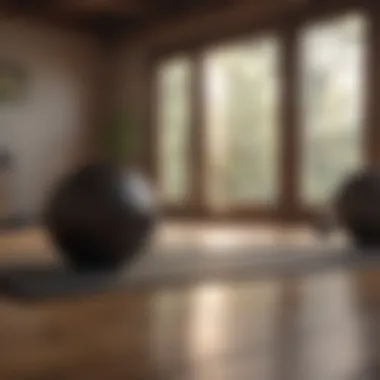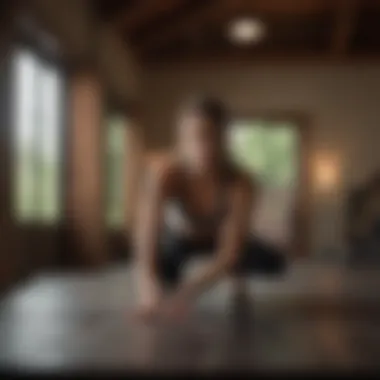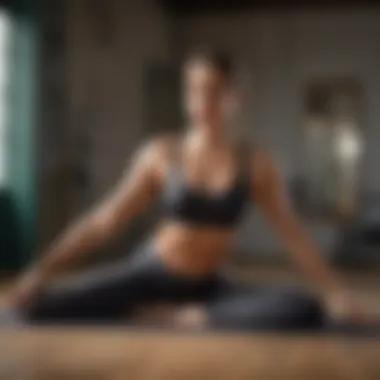Mastering Pilates: A Home Practice Guide


Intro
Practicing Pilates at home is becoming increasingly popular. The convenience and flexibility it offers are appealing to many. Whether you are a beginner or have experience in Pilates, you can benefit greatly from establishing a home practice. The home environment allows you to control your space, schedule, and intensity of workouts. This guide aims to provide you with the critical information needed to start and maintain your Pilates practice effectively while ensuring that you avoid common pitfalls.
Key Benefits
Physical Health Benefits
Pilates provides numerous physical health benefits. One of the most significant advantages is improved core strength. A strong core can enhance stability in daily activities. It can also reduce the risk of injuries. Furthermore, Pilates promotes better posture by strengthening the muscles that support the spine. This improvement in alignment has a ripple effect on overall body functionality.
In addition to core strength, Pilates enhances flexibility. Many Pilates exercises focus on stretching muscles, which can lead to greater mobility. This is especially important as we age. Improved flexibility can also enhance athletic performance, making Pilates a beneficial complement to other types of physical activities.
Mental Well-being Enhancements
The mental benefits of practicing Pilates at home are equally crucial. Engaging in physical activity releases endorphins, which can improve mood and decrease feelings of anxiety or depression. The mindful approach in Pilates, which emphasizes breath control and body awareness, contributes to a more centered mental state.
Regular practice can also lead to improved focus and concentration. Many practitioners find that committing time to Pilates fosters a sense of calm and mindfulness, enhancing mental resilience in daily life.
"Mindfulness in movement promotes not only physical wellness but also emotional balance."
Practical Tips
Effective Meal Planning
To complement your Pilates practice, proper nutrition is essential. Meal planning helps ensure you provide your body with the nutrients it needs to perform optimally. Focus on a balanced diet that includes:
- Lean proteins (chicken, fish, legumes)
- Whole grains (quinoa, brown rice, oats)
- Fruits and vegetables (varied colors for different nutrients)
- Healthy fats (avocado, nuts, olive oil)
Consider prepping meals in advance to save time during the week. Be mindful of portion sizes, as consuming the right amount will support your energy levels for practice.
Quick and Efficient Workouts
Finding time to practice can be challenging. Here are some tips for quick and effective workouts:
- Set aside 15-30 minutes daily for Pilates practice.
- Choose exercises that engage multiple muscle groups to maximize your time.
- Utilize online resources for guided sessions – many platforms provide free or subscription-based classes catered for various levels.
Involve family members or a workout buddy to make it more enjoyable and hold each other accountable.
Overall, establishing a routine grounded in well-being is fundamental for enhancing your Pilates practice at home. Prioritizing both physical and mental aspects ensures a holistic approach that benefits your journey.
Prelude to Pilates
Pilates stands as a pivotal practice for individuals focusing on physical conditioning and mental well-being. This method transcends mere physical exercise; it cultivates a holistic approach to body awareness, mindfulness, and functional movement. Understanding the foundations of Pilates is essential for anyone looking to initiate or enhance their home practice.
History and Evolution of Pilates
The origins of Pilates can be traced back to the early 20th century, developed by Joseph Pilates, a German physical trainer. He created this system as a means to rehabilitate injured soldiers during World War I. Joseph combined principles of yoga, martial arts, and gymnastics to create a series of exercises that emphasized core strength, flexibility, and overall body alignment. Over the decades, this practice has evolved, integrating various influences and adjusting to contemporary fitness trends. Today, Pilates is recognized worldwide, embraced by injury rehabilitation specialists and fitness enthusiasts alike.
Benefits of Practicing Pilates
Engaging in Pilates offers numerous advantages. Key benefits include:
- Enhanced Core Strength: Pilates fundamentally focuses on core muscles, which support posture and balance.
- Improved Flexibility: Regular practice encourages increased range of motion in joints and muscles, leading to reduced risk of injury.
- Mind-Body Connection: The focus on breath and alignment fosters greater body awareness and mindfulness, essential for stress reduction.
- Postural Improvement: Through its emphasis on alignment and stabilization, Pilates aids in correcting postural imbalances that can cause discomfort or pain.
- Low Impact: The exercises are gentle on the body, making it accessible for individuals of all fitness levels.
"Pilates is an intelligent form of exercise designed to build strength and improve posture, balance, and flexibility."
Overall, understanding the history and benefits of Pilates sets the groundwork for a successful practice at home.


Preparing for Your Home Practice
Preparing for a Pilates practice at home involves more than just rolling out a mat. It sets the foundation for an effective session. The right setup influences performance, focus, and safety. By considering important elements such as space and equipment, individuals can create an environment conducive to achieving their wellness goals.
Choosing a Suitable Space
The environment where one practices Pilates can significantly affect motivation and performance. Ideally, this space should be quiet, spacious, and free from distractions. A clear area allows for the full range of movement necessary for Pilates exercises.
- Lighting: Natural light can enhance the experience. If natural light is limited, consider warm lamps to create a calming effect.
- Surface: A soft floor helps protect joints. Practice on carpet, or use a thick yoga mat to cushion movements.
- Ventilation: Ensure good airflow. Open a window or use a fan to keep the space comfortable.
Such considerations can turn a simple room into a personal sanctum for practice, which may enhance focus and reduce stress.
Essential Equipment and Props
Having the right equipment at home makes practicing Pilates more enjoyable and effective. Each piece of equipment contributes uniquely to various exercises. The essentials include a yoga mat, resistance bands, and a stability ball.
Yoga Mat
A yoga mat is a fundamental item for Pilates practice. It creates a designated space for workouts and offers cushioning for the body. A quality yoga mat, typically thicker than standard ones, provides stability and grip, reducing the risk of slipping during exercises. With many textures available, it can improve traction, beneficial for both beginner and advanced practitioners.
Key characteristic: Durability is crucial; mats should resist wear over time, especially with regular use.
Advantages: A good mat helps with balance, supports diverse exercises, and protects joints.
Resistance Bands
Resistance bands are versatile tools that add resistance to Pilates routines. They help enhance strength and flexibility, allowing for a more dynamic workout. Available in various resistance levels, these bands can adapt to different fitness levels, making them suitable for everyone.
Key characteristic: Bands are portable; they can easily fit into a bag, making them great for practice on the go.
Advantages: They assist in muscle engagement and can modify exercises to fit personal needs, pushing individuals to challenge their limits in a controlled manner.
Stability Ball
A stability ball plays a significant role in enhancing core stability and balance. It engages different muscles while performing standard Pilates exercises, offering an additional layer of challenge. Using a stability ball also helps with posture by promoting spinal alignment during movements.
Key characteristic: The instability of the ball activates core muscles more effectively than flat surfaces.
Advantages: It enhances balance and coordination, making workouts more demanding. However, it should be used with caution to avoid falling or losing stability, especially for beginners.
Preparing these elements enables a structured and effective Pilates practice at home. The combination of correct space and suitable equipment supports a successful home workout routine.
Foundational Pilates Exercises
Practicing foundational Pilates exercises is crucial for establishing a strong base in your routine. These exercises engage the core, improve flexibility, and enhance overall body awareness. Focusing on the fundamentals prepares individuals for more advanced movements, ensuring a safer and more effective practice. Beginners particularly benefit from these foundational exercises because they build confidence and create a deeper understanding of body mechanics. Furthermore, understanding foundational principles aids in the prevention of injuries, as these basic movements set the stage for proper alignment and technique throughout one’s Pilates journey.
Understanding Core Engagement
Core engagement is a fundamental aspect of Pilates. It involves activating the muscles of the abdomen, lower back, hips, and pelvis. This activation provides stability and support for the spine during exercises. Proper core engagement creates a solid foundation for movement, allowing for greater precision and control. It also helps to protect the spine from strain or injury. During Pilates practice, it is essential to focus on engaging the core correctly. This effort does not merely enhance performance but fosters a connection between the mind and body, which is pivotal in Pilates philosophy.
Key Exercises for Beginners
Pilates consists of a range of exercises that can seem daunting for beginners. However, starting with a few key exercises can facilitate smoother entry into the practice. Here are three foundational exercises:
Roll-Up
The Roll-Up is an essential exercise that emphasizes spinal articulation. It contributes to overall core strengthening and increases flexibility in the spine. A key characteristic of the Roll-Up is its capacity to teach proper sequencing of movements; this is pivotal in developing coordination and balance. A unique feature of the Roll-Up is that it can be adjusted in difficulty by incorporating props, such as resistance bands. This adjustment allows beginners to focus on form without overexerting themselves. While the Roll-Up is beneficial for core strength, some may find it challenging initially, especially if they have tight hamstrings or lower back discomfort.
Leg Circles


Leg Circles are another foundational exercise that promotes hip stability and core control. This exercise not only strengthens the abdominal muscles but also enhances flexibility in the legs. A crucial aspect of Leg Circles is the ability to isolate movements, which cultivates body awareness and fosters mindful practice. The unique feature is that they can be performed lying down, providing support for the back. One advantage of Leg Circles is their versatility; they can be modified for various fitness levels. However, beginners may struggle with maintaining proper engagement throughout the exercise if they lack core awareness.
Bridge
The Bridge exercise focuses on strengthening the glutes and lower back while promoting pelvic stability. Its contribution to overall body alignment is significant, making it not only a staple in Pilates but also a rehabilitation tool. The key characteristic of the Bridge is its ability to engage multiple muscle groups simultaneously, enhancing synergy in movement. A distinctive feature is that it encourages active stretching across the hip flexors, which can help alleviate tightness. While it is generally a beneficial exercise, those with existing back issues should approach it cautiously and consult professionals before practice.
Proper engagement and alignment throughout foundational exercises are key to maximizing benefits and reducing the risk of injury as you develop your Pilates practice.
Structuring Your Pilates Routine
When practicing Pilates at home, structuring your routine is crucial. A well-structured routine not only provides consistency but also enhances overall effectiveness. It allows individuals to set clear goals and track their progress. Moreover, a structured approach aids in avoiding burnout or injury. With varying levels of exercises incorporated into the practice, one can maintain engagement and motivation.
Creating a Schedule
Frequency of Practice
Establishing the frequency of practice is pivotal for achieving desired results. Regular sessions promote muscle memory and help in building strength over time. Generally, practicing Pilates three to five times a week is recommended. This frequency allows for sufficient recovery while keeping the body engaged. It balances the need for regular movement without overwhelming your body.
Additionally, a consistent practice fosters discipline. Individuals can easily form a habit if sessions are scheduled regularly. This rhythmic commitment has been shown to improve not only physical strength but also mental resilience. However, the frequency must cater to the individual's body and lifestyle.
Duration of Sessions
The duration of each session also significantly impacts the effectiveness of the routine. Most Pilates sessions range from 30 to 60 minutes. Shorter sessions can be just as beneficial, especially for beginners or those pressed for time. Engaging in shorter, focused workouts five times a week can often yield better results than longer, sporadic sessions.
One unique characteristic of shorter sessions is their accessibility; they are easier to fit into a busy lifestyle. This can be an effective choice for individuals who may feel overwhelmed by longer commitments. However, longer sessions allow for greater exploration of exercises, leading to deeper understanding and engagement.
Integrating Different Levels of Difficulty
Incorporating various levels of difficulty within your Pilates routine is essential. It adds diversity and challenges the body in different ways. Beginners may start with basic exercises to build a solid foundation. As competency grows, introducing intermediate and advanced exercises can elevate the practice.
This gradual progression is beneficial for maintaining interest and motivation. It also supports continual physical development. Adjusting the levels of difficulty can prevent plateaus and make the practice more engaging. Tailoring workouts to match one's evolving skills enhances self-confidence, ultimately leading to a more enjoyable experience.
Maintaining Proper Form
Maintaining proper form during Pilates practice is crucial for maximizing effectiveness and preventing injury. Pilates emphasizes control, strength, and precision in movements. When correctly executed, exercises strengthen and align the body efficiently. On the contrary, poor form can lead to strain and reduce the exercise's benefits.
Several elements contribute to maintaining proper form. These include alignment, core engagement, and breath control. Proper alignment ensures that the body's weight is evenly distributed. This prevents overexertion of muscles and joints. Engaging the core creates a stable foundation, essential for supporting movements throughout a routine. Furthermore, breath control enhances the effectiveness of each exercise. It allows for deeper engagement of muscles and helps maintain focus.
Overall, the benefits of maintaining proper form extend beyond a workout session. It makes practitioners more aware of their body mechanics, fostering a sense of mindfulness. With consistent attention to form, individuals can experience improved strength, flexibility, and balance over time.
Importance of Alignment
Alignment in Pilates refers to positioning the body correctly in different exercises. Achieving optimal alignment is an essential component for effective practice. When the body is aligned, it functions more efficiently. This reduces the risk of tension in muscles and joints.
Proper alignment can be determined by several key factors:
- Head and neck position: Keep the head in line with the spine. Avoid straining the neck.
- Shoulders: Shoulders should be relaxed and positioned away from the ears. This allows for proper chest opening and spine extension.
- Pelvis and spine: The pelvis must be neutral, and the spine aligned in its natural curve. This supports proper core engagement.
Practicing these alignment tips not only improves performance in Pilates but also facilitates better posture in daily life.
Common Errors to Avoid
Understanding common errors in Pilates can drastically improve practice quality. Here are several frequent mistakes practitioners make:
- Holding your breath: This results in tension and limitse effectiveness. Focus on breathing continuously with each movement.
- Overextension: Avoid forcing the body into extreme positions. This can lead to injury or strain. Always work within your limits.
- Neglecting the core: Engaging the core is vital for stability. Failing to do so can lead to poor movement patterns.
- Poor control: Pilates emphasizes flowing movements. Jerky motions can compromise alignment and lead to injury.
By paying attention to alignment and avoiding these common errors, practitioners can achieve a more rewarding and injury-free Pilates experience. Proper focus on form shapes the foundation for an effective home practice.


Using Online Resources
In today’s digital age, utilizing online resources has become a pivotal part of practicing Pilates at home. These tools cater to varying levels of experience and assist individuals in enhancing their practice. The availability of information can be overwhelming, but when leveraged correctly, it can lead to significant improvements in understanding and executing Pilates exercises.
Finding Qualified Instructors
One of the most crucial steps is finding qualified instructors who can guide you through your Pilates journey. Many online platforms offer a variety of instructors with different specializations. Websites such as Yoga Journal and Pilates Anytime have a variety of certified Pilates instructors ready to help. Here are some considerations to keep in mind:
- Certification: Ensure that the instructor possesses recognized certifications, such as those from the Pilates Method Alliance.
- Experience: Look for instructors who have experience with the specific style of Pilates you want to practice, be it Mat Pilates or Reformer Pilates.
- Reviews: Check the feedback from other students. Positive reviews often indicate a teacher’s effectiveness.
- Personal Connection: A good rapport can make a significant difference in how effectively you learn and progress. Look for instructors who resonate with you.
Utilizing Video Tutorials
Video tutorials have become a cornerstone for many home practitioners. They provide visual guidance which is often necessary for understanding complex movements and ensuring correct form. Here are some advantages of using video tutorials:
- Variety of Content: Platforms like YouTube or Vimeo offer a wide range of videos catering to all levels, from beginner to advanced workouts.
- Visual Learning: Seeing exercises performed can clarify difficult concepts and help prevent injuries through better comprehension of movement mechanics.
- Flexibility: Videos allow you to practice at your own pace, and you can pause, rewind, or redo exercises as needed.
- Specific Focus: Many tutorials address specific topics, such as core engagement or flexibility work, offering targeted practice sessions.
"Finding the right resources online can be just as beneficial as attending a class in person, especially when you prioritize quality and effectiveness."
Tracking Your Progress
Tracking your progress in Pilates is crucial for sustaining motivation and ensuring effective practice. For individuals practicing at home, it can sometimes be difficult to gauge improvement without the guidance of an instructor. However, maintaining a record not only quantifies your achievements but also helps in identifying areas that may require more focus.
Setting Personal Goals
Setting personal goals is a proactive step towards enhancing your Pilates practice. Goals provide direction and clarity. When you embark on this journey, consider what you wish to accomplish. Is it improving strength, flexibility, or endurance? Clear, specific tasks like "performing 10 roll-ups" or "holding a bridge for 1 minute" can be very effective. This specificity allows for measurable outcomes.
- Focus on SMART Goals
- Specific: Define exact areas of focus.
- Measurable: Determine how you will measure success.
- Achievable: Goals should be realistic.
- Relevant: Ensure they align with your greater ambitions in wellness.
- Time-bound: Set deadlines to create urgency.
Moreover, documenting these goals can help you reflect over time on what worked and what did not. A written journal can facilitate this process, helping you stay organized.
Evaluating Improvements Over Time
Regular evaluations of your progress form an integral part of personal development in Pilates. Set intervals – every month, for instance – to review your achievements. During these evaluations, ask yourself:
- Have I met my previously set goals?
- What exercises have become easier?
- Are there movements I still find challenging?
- How do I feel physically and mentally?
Tracking these reflections contributes to a deeper understanding of your practice. Observations may reveal trends in strength and flexibility, identifying specific areas for improvement.
Personal evaluations allow for the adjustment of goals and routines. If a previously set goal seems too easy or too difficult, it is okay to modify it. This adaptability is an essential aspect of growth and keeps the practice engaging.
Remember, progress is not always linear. Skills may improve in bursts, and that's normal.
In summary, tracking your progress can deepen your engagement with Pilates. Setting clear personal goals and regularly evaluating your improvements ensures a tailored approach, making your journey rewarding and effective.
Ending
In the context of establishing a Pilates practice at home, the conclusion serves as a pivotal element that consolidates the insights gained throughout the article. It invites readers to reflect on the principles discussed and encourages them to take actionable steps in their journey. The essence of Pilates revolves around mindfulness, focus, and physical orientation, all of which benefit from a structured home routine.
The importance here is multifaceted. First, it reinforces the understanding that consistent practice can lead to substantial improvements in core strength, flexibility, and overall well-being. Secondly, it reiterates the significance of tracking progress, which was emphasized throughout previous sections, ensuring that individuals not only set goals but regularly evaluate their advancement. Finally, the conclusion becomes a motivating force, propelling readers to integrate Pilates into their daily lives efficiently and sustainably.
Recap of Key Takeaways
A synthesis of the discussed points highlights several key takeaways for readers aiming to practice Pilates at home.
- Choosing the Right Space: Make sure to find a calming and spacious area that allows for fluid movement.
- Essential Equipment: Invest in basic Pilates gear such as a quality yoga mat, resistance bands, and possibly a stability ball.
- Foundational Exercises: Focus on mastering core engagement with key exercises like the Roll-Up, Leg Circles, and the Bridge.
- Routine Structure: Develop a consistent schedule and incorporate variations in difficulty to prevent monotony and keep the practice engaging.
- Form and Technique: Prioritize alignment and be aware of common mistakes that can undermine effectiveness and safety.
- Use of Online Resources: Take advantage of qualified instructors and video tutorials to refine your practice.
- Goal Setting and Progress Tracking: Set achievable goals and regularly evaluate progress to stay motivated.
Encouragement for Ongoing Practice
Lastly, encouraging ongoing practice is fundamental in integrating Pilates as a regular aspect of health and wellness. Cultivating a habit takes time, and individuals should remain patient with themselves.
- Start slow and build up: It is completely normal to feel overwhelmed at first.
- Embrace variations: As skills develop, introduce more complex movements into your routine. This keeps the practice fresh and challenging.
- Community connection: Engage with fellow practitioners online through platforms such as Reddit or Facebook groups, which can offer both motivation and support.
- Stay informed: The Pilates community is vast, so staying updated on new techniques or insights allows for continuous growth.
Ultimately, the pursuit of Pilates at home is not merely about the physical practice but also an invitation to cultivate a more mindful and balanced approach to lifestyle. The benefits extend beyond the mat into daily life, promoting overall well-being.















